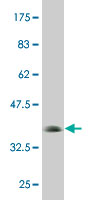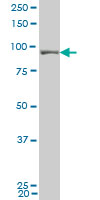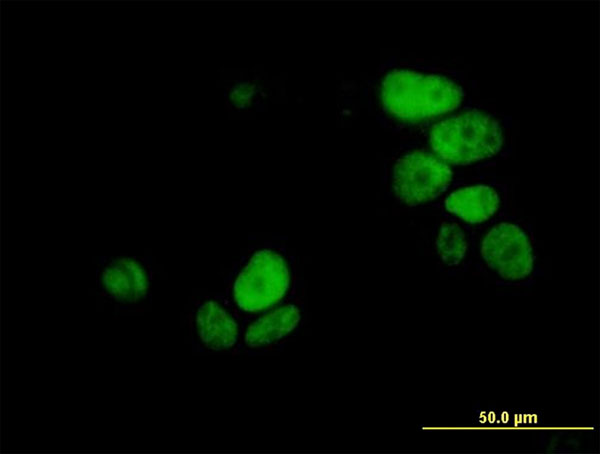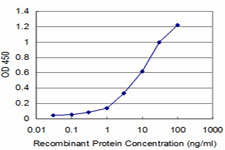UHRF1 Antibody (monoclonal) (M02)
Mouse monoclonal antibody raised against a partial recombinant UHRF1.
- 产品详情
- 实验流程
- 背景知识
Application
| WB, IF, E |
|---|---|
| Primary Accession | Q96T88 |
| Other Accession | NM_013282 |
| Reactivity | Human |
| Host | mouse |
| Clonality | monoclonal |
| Isotype | IgG1 Kappa |
| Clone Names | 3B12 |
| Calculated MW | 89814 Da |
| Gene ID | 29128 |
|---|---|
| Other Names | E3 ubiquitin-protein ligase UHRF1, 632-, Inverted CCAAT box-binding protein of 90 kDa, Nuclear protein 95, Nuclear zinc finger protein Np95, HuNp95, hNp95, RING finger protein 106, Transcription factor ICBP90, Ubiquitin-like PHD and RING finger domain-containing protein 1, hUHRF1, Ubiquitin-like-containing PHD and RING finger domains protein 1, UHRF1, ICBP90, NP95, RNF106 |
| Target/Specificity | UHRF1 (NP_037414, 694 a.a. ~ 793 a.a) partial recombinant protein with GST tag. MW of the GST tag alone is 26 KDa. |
| Dilution | WB~~1:500~1000 IF~~1:50~200 E~~N/A |
| Format | Clear, colorless solution in phosphate buffered saline, pH 7.2 . |
| Storage | Store at -20°C or lower. Aliquot to avoid repeated freezing and thawing. |
| Precautions | UHRF1 Antibody (monoclonal) (M02) is for research use only and not for use in diagnostic or therapeutic procedures. |
For Research Use Only. Not For Use In Diagnostic Procedures.
Provided below are standard protocols that you may find useful for product applications.
BACKGROUND
This gene encodes a member of a subfamily of RING-finger type E3 ubiquitin ligases. The protein binds to specific DNA sequences, and recruits a histone deacetylase to regulate gene expression. Its expression peaks at late G1 phase and continues during G2 and M phases of the cell cycle. It plays a major role in the G1/S transition by regulating topoisomerase IIalpha and retinoblastoma gene expression, and functions in the p53-dependent DNA damage checkpoint. Multiple transcript variants encoding different isoforms have been found for this gene.
REFERENCES
Disruption of Dnmt1/PCNA/UHRF1 interactions promotes tumorigenesis from human and mice glial cells. Hervouet E, et al. PLoS One, 2010 Jun 29. PMID 20613874.Association of genetic variants with hemorrhagic stroke in Japanese individuals. Yoshida T, et al. Int J Mol Med, 2010 Apr. PMID 20198315.Assessment of a polymorphism of SDK1 with hypertension in Japanese Individuals. Oguri M, et al. Am J Hypertens, 2010 Jan. PMID 19851296.UHRF1 recruits the histone acetyltransferase Tip60 and controls its expression and activity. Achour M, et al. Biochem Biophys Res Commun, 2009 Dec 18. PMID 19800870.Np95 interacts with de novo DNA methyltransferases, Dnmt3a and Dnmt3b, and mediates epigenetic silencing of the viral CMV promoter in embryonic stem cells. Meilinger D, et al. EMBO Rep, 2009 Nov. PMID 19798101.
终于等到您。ABCEPTA(百远生物)抗体产品。
点击下方“我要评价 ”按钮提交您的反馈信息,您的反馈和评价是我们最宝贵的财富之一,
我们将在1-3个工作日内处理您的反馈信息。
如有疑问,联系:0512-88856768 tech-china@abcepta.com.























 癌症的基本特征包括细胞增殖、血管生成、迁移、凋亡逃避机制和细胞永生等。找到癌症发生过程中这些通路的关键标记物和对应的抗体用于检测至关重要。
癌症的基本特征包括细胞增殖、血管生成、迁移、凋亡逃避机制和细胞永生等。找到癌症发生过程中这些通路的关键标记物和对应的抗体用于检测至关重要。 为您推荐一个泛素化位点预测神器——泛素化分析工具,可以为您的蛋白的泛素化位点作出预测和评分。
为您推荐一个泛素化位点预测神器——泛素化分析工具,可以为您的蛋白的泛素化位点作出预测和评分。 细胞自噬受体图形绘图工具为你的蛋白的细胞受体结合位点作出预测和评分,识别结合到自噬通路中的蛋白是非常重要的,便于让我们理解自噬在正常生理、病理过程中的作用,如发育、细胞分化、神经退化性疾病、压力条件下、感染和癌症。
细胞自噬受体图形绘图工具为你的蛋白的细胞受体结合位点作出预测和评分,识别结合到自噬通路中的蛋白是非常重要的,便于让我们理解自噬在正常生理、病理过程中的作用,如发育、细胞分化、神经退化性疾病、压力条件下、感染和癌症。









